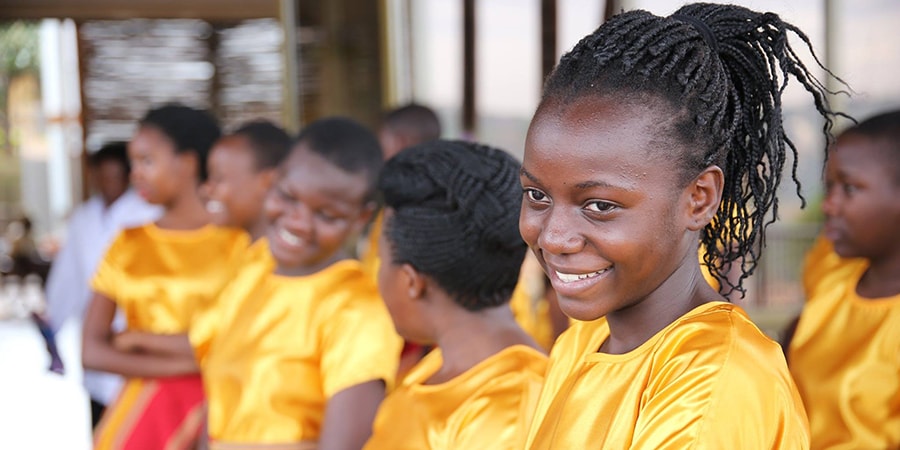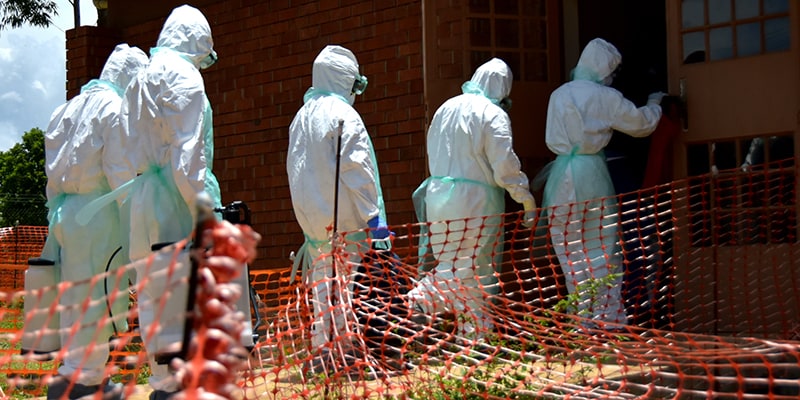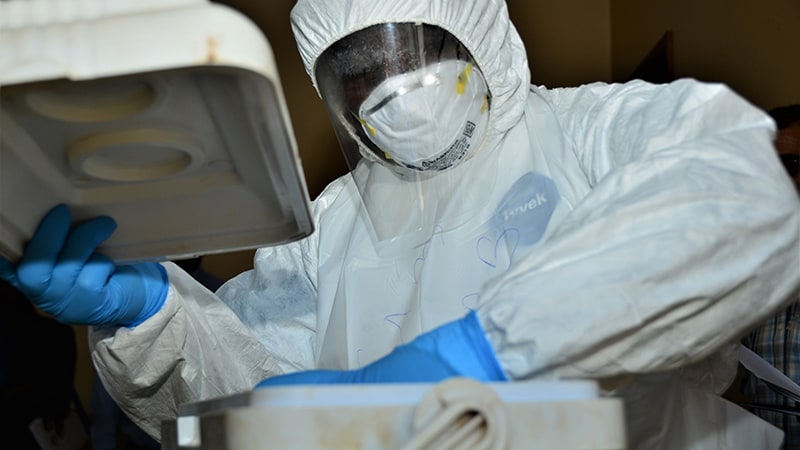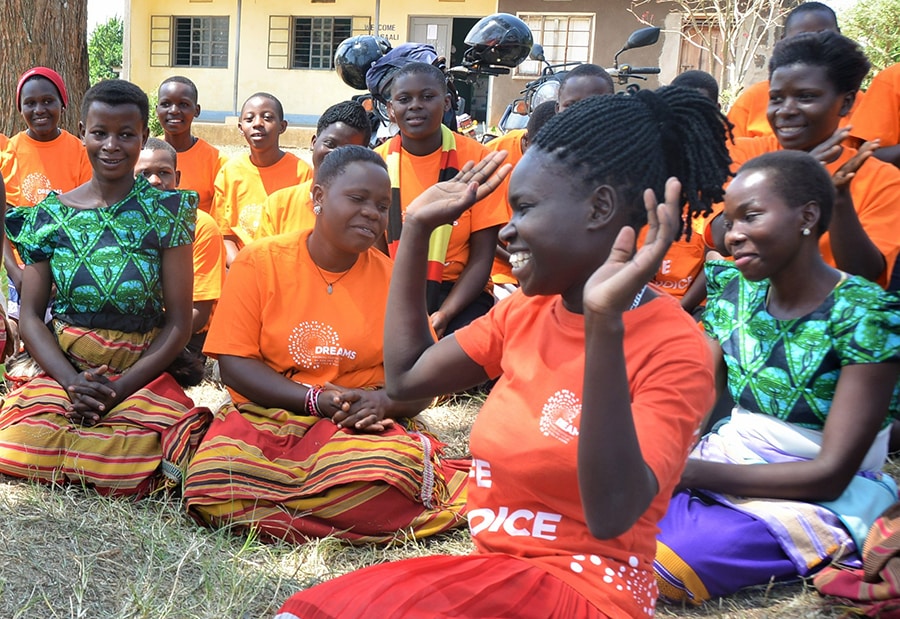CDC in Uganda

Adolescents who were born with HIV and receive care from Baylor-Uganda, CDC’s partner, participate in events during a U.S. congressional delegation visit. Photo by Charles Opolot / Baylor-Uganda.
The Centers for Disease Control and Prevention (CDC) began working in Uganda in 1991 and officially established a country office in 2000. CDC works with the Ministry of Health (MOH) and other partners to deliver evidence-based health services to prevent, control, and treat HIV/AIDS. CDC also supports tuberculosis (TB) and malaria control efforts, and maternal and child health services, including vaccination. CDC works with partners to strengthen Uganda’s capacity to prevent, detect, and respond to public health threats such as the COVID-19 pandemic.
CDC works with the Ministry of Health (MOH) and local partners to support activities across the 11 technical areas outlined in the Global Health Security Agenda (GHSA). These action packages help Uganda build core public health capacities in disease surveillance, laboratory systems, workforce development, and emergency management. One crucial asset to Uganda’s public health system is the national Public Health Emergency Operations Center (PHEOC) that the MOH established in 2014 with CDC support. The PHEOC serves as a hub for coordinating preparedness, response, and recovery from public health emergencies. The PHEOC monitors health threats in real-time, coordinates with a network of national laboratories to rapidly identify the source of disease, trains epidemiologists, and has rapid response teams at the ready.

Health workers practice escorting an Ebola patient into an isolation center during Ebola simulation exercise in 2019. Photo by Irene Nabusoba/CDC
Since 2014, the CDC-supported PHEOC responded to more than 270 events, including outbreaks of yellow fever, Ebola, Marburg, Rift Valley fever, Crimean Congo hemorrhagic fever, influenza, measles, cholera, typhoid, meningitis, and anthrax
CDC supports strengthened health screening at Entebbe International Airport and ground crossing points across the country, including Mpondwe in southwestern and Malaba in eastern Uganda
CDC supports Uganda to maintain polio-free status and strengthen the Expanded Program for Immunization (EPI) system that prevents, detects, and responds to outbreaks of vaccine-preventable diseases
CDC began supporting the MOH in 2003 to build a robust laboratory network that provides efficient and effective diagnostic and surveillance services. CDC supports enhanced laboratory infrastructure and equipment procurement to increase the laboratory network’s diagnostic capacity. This strengthened laboratory network enables prompt and accurate results that inform clinical decisions, outbreak response, policies, and programs. CDC also uses the Strengthening Laboratory Management Toward Accreditation (SLMTA) approach to train laboratory managers to implement quality management systems in areas with limited resources. CDC’s support in Uganda contributed to increased timeliness, reliability, and accuracy of testing. Ugandan laboratories experience fewer adverse safety incidents and higher confidence in laboratory services due to increased quality, lower wait times for patients, and enhanced interactions with clinicians.

A participant in the 2019 Ebola simulation exercise practices safe transfer of samples that would be transported to the CDC-supported Ebola laboratory at the Uganda Virus Research Institute (UVRI) in Entebbe.
CDC supported 34 Ugandan laboratories to attain international accreditation using the SLMTA approach
CDC’s SLMTA efforts include support for the national biosafety level 3 reference laboratory for viral hemorrhagic fevers. CDC also supports the HIV Early Infant Diagnosis-Viral Load, National Microbiology, and National Tuberculosis reference laboratories
CDC supported development of Uganda’s first national health laboratory services policy in 2009 and national strategic plans for 2010-2015 and 2016-2022
CDC supported development of a strategy to recruit and retain highly qualified laboratory professionals within the Department for National Health Laboratory and Diagnostic Services
CDC helped develop a network for integrated specimen transport and result transmission. This network increased crucial outbreak response capacities to rapidly move specimens and return results
CDC supported establishment of the MOH’s National Equipment Calibration and Maintenance Center, which provides maintenance to equipment that is critical to laboratory services
CDC supported refurbishment of the Uganda Virus Research Institute-Arua laboratory, which focuses on regional outbreak response for infectious diseases such as plague
CDC’s laboratory investments and support contributes to rapid detection of cross-border cases and zero human cases of plague diagnosed among Ugandans since 2015
Field Epidemiology Training Program (FETP)
CDC partnered with the MOH and Makerere University School of Public Health to establish a two-year, national FETP in 2015. FETPs train epidemiologists to identify and contain outbreaks before they become epidemics. Participants strengthen their skills in data collection and translation of data into evidence-based action. Uganda’s FETP-Advanced, also known as the Public Health Fellowship Program, is the only field epidemiology training program in Africa that enrolls post-master’s degree fellows. In August 2021, CDC and partners launched Uganda’s first FETP-Intermediate, a nine-month training program for health professionals working at Regional Referral Hospitals. In early 2021, CDC also re-launched FETP-Frontline, a three-month training program for district health workers.
As of September 2021, FETP fellows investigated 260 outbreaks, conducted 271 epidemiologic studies and quality improvement projects, and published 61 manuscripts in peer-reviewed journals
Uganda’s FETP has won many awards at local and international conferences, including the 2017 CDC Director’s Award and the Jeffrey P. Koplan Award for Excellence in Scientific Poster Presentation in 2016 and 2022
In collaboration with the MOH, FETP-Advanced fellows and graduates conducted 67 projects focused on COVID-19 between March 2020 and September 2021
In 2021 Uganda’s FETP won the CDC Director’s Award for Excellence in Outbreak and Public Health Response for their contributions to the national COVID-19 response
COVID-19
The first case of COVID-19 in Uganda was confirmed on March 21, 2020. Since the pandemic was declared, CDC has worked with local partners to prevent the spread of COVID-19 across borders and within health facilities. Throughout the pandemic, CDC continued to focus on key tuberculosis (TB), HIV, and malaria programs. CDC supports emergency operations, promotes the COVID-19 vaccine, and enhances laboratory, diseases surveillance, and workforce capacities. Previous collaborations between CDC and the MOH to expand regional laboratory capacities to conduct PCR tests and community-based surveillance were critical to the country’s COVID-19 response. FETP fellows and graduates greatly contributed to the response by coordinating early airport screening activities, contact tracing, data management, call center management, surveillance analysis, and vaccine studies. FETP personnel also conducted outbreak investigations, risk mapping, and epidemiological studies in sub-populations living at higher risk of COVID-19.
CDC supports the MOH to establish regional PHEOCs across the country to enhance the country’s response to COVID-19 and concurrent public health emergencies
The MOH and CDC have established regional PHEOCs in Mbale, Arua, Fort Portal, Masaka, Hoima, Kampala Metropolitan Area to ensure real-time exchange of information, strategies, and best practices between national and sub-national entities
CDC partnered with religious organizations and health care providers through the Faith-Based Initiative program to disseminate COVID-19 prevention messages and increase vaccine uptake
CDC supported partners and health facilities to locally produce alcohol-based hand rubs at nearly half the price of common commercial hand sanitizers. This effort increased access to hand hygiene resources that help prevent COVID-19
CDC provided financial and technical support to one of Uganda’s largest public research laboratories to sequence SARS-CoV-2, the virus that causes COVID-19. This support increased understanding of epidemiological trends, which informed the MOH’s pandemic response and management
HIV and Tuberculosis (TB)
CDC assisted the development of an integrated national, regional, and district service-delivery model that enhances health system capacity to respond to HIV and TB in Uganda. Throughout the COVID-19 pandemic, CDC has worked to continue HIV and TB service delivery, ensure strategic HIV testing, and retain HIV and TB clients on treatment. CDC also works with local partners to:
- Strengthen TB prevention and control services
- Find people living with HIV, expand antiretroviral treatment (ART), and increase viral load testing
- Eliminate mother-to-child HIV transmission
- Increase access and uptake of HIV pre-exposure prophylaxis (PrEP)
- Monitor and expand voluntary medical male circumcision (VMMC) services and develop guidelines
- Implement non-communicable disease prevention and management services
- Scale-up routine cervical cancer services for women living with HIV
- Prevent HIV among young women and adolescent girls through the Determined, Resilient, Empowered, AIDS-free, Mentored, and Safe (DREAMS) program
- Support the MOH to design, maintain, improve, and use health information systems, and conduct research and disease surveillance

Participants in Uganda’s Determined, Resilient, Empowered, AIDS-free, Mentored, and Safe (DREAMS) program interact with CDC staff. Photo by Irene Nabusoba/CDC
More than 700,000 men, women, and children living with HIV in Uganda received ART in 2021
Despite the COVID-19 pandemic, HIV treatment outcomes continued to improve with viral load suppression rates reaching over 95% in 2021
CDC works with partners to develop PrEP technical and policy guidelines and conduct routine monitoring activities
In 2021, nearly 67,000 people living with higher risk of HIV started pre-exposure prophylaxis (PrEP) in CDC-supported regions
More than 153,000 voluntary medical male circumcisions were performed in 2021 by CDC partners, which prevented over 8,000 new HIV infections
CDC builds upon decades of experience in implementing youth-friendly and community-centered HIV programs by supporting the DREAMS program in 15 districts
In 2021, more than 109,000 adolescent girls and young women received DREAMS services in CDC-supported regions
CDC helped establish Uganda’s first Medically Assisted Therapy program at the Butabika National Referral Mental Hospital in 2020. This program helps treat and rehabilitate persons who inject drugs, a population who experiences increased risk of HIV infection
The Medically Assisted Therapy program has enrolled 275 individuals with a 71% six-month retention rate since October 2020
CDC, the MOH, and other partners conducted the 2020-2021 Uganda Population-based HIV Impact Assessment (UPHIA), which provided data to inform HIV epidemic control strategy
In partnership with the Government of Uganda, CDC conducted the first ever UPHIA focused on refugees
Since 2005, CDC supported the Uganda Prisons Service (UPS) to provide diagnostic and clinical services for HIV, sexually transmitted infections, TB, and COVID-19. CDC’s support includes on-entry and daily TB screening and contact tracing
CDC opened a multi-drug resistant TB (MDR-TB) treatment center at the UPS headquarters in Murchison Bay Maximum Prison. This center is the sole referral and management center for incarcerated patients with MDR-TB in Uganda
CDC equipped and furnished the MDR-TB center at the UPS headquarters and trained and mentored the UPS medical team to manage care for incarcerated patients living with MDR-TB
CDC renovated laboratories in five regional referral hospitals to increase timely diagnosis and referral of MDR-TB cases among people who are incarcerated
CDC is providing six GeneXpert machines to regional prisons. This state-of-the-art diagnostic equipment enables prisons to diagnose MDR-TB within a few hours, instead of weeks
CDC helped procure 14 motorcycles so that prisons without GeneXpert machines can transport samples to other facilities with diagnostic capacity. This effort helps ensure that potential MDR-TB cases are detected and treated
Malaria
Under the U.S. President’s Malaria Initiative (PMI), CDC assigned a resident advisor to support malaria prevention and control activities in Uganda. CDC helps provide long-lasting insecticide-treated nets and indoor residual spray (IRS), prevent malaria during pregnancy, and strengthen diagnostics and case management. CDC partners with the National Malaria Control Division to conduct operational research, surveillance, monitoring, and evaluation. CDC’s monitoring support focuses on bed net durability and insecticide and antimalarial resistance.
Through the U.S. President’s Malaria Initiative (PMI), CDC helped distribute 1.9 million bed nets, 1.2 million malaria rapid diagnostic tests, and 1.2 million artemisinin-based combination therapies in 2021
In 2021, an indoor residual spray (IRS) campaign that covered 1 million structures helped protect 3.8 million people from malaria
Since PMI was launched in Uganda in 2006, malaria prevalence decreased by 78% and all-cause child mortality decreased by 53% among children under 5 years old
Ugandan healthcare facilities produce own Alcohol-Based Hand Rub during COVID-19 | CDC
Preparedness pays off with quick response time (cdc.gov)
Uganda’s Disease Detectives Increase Contributions to Critical PEPFAR Priority Areas | CDC
Celebrating 15 Years of a Successful Partnership | CDC
Strong Partnerships and CDC Investments Support Uganda’s Rapid Response to COVID-19 | CDC
Bringing back HIV patients that stop treatment in Uganda (cdc.gov)
Integrating TB Services into Maternal and Child Health Clinics in Rural Uganda (cdc.gov)
One good turn deserves another: Uganda hosted STOP training for the third time (cdc.gov)
- 15 U.S. Assignees
- 101 Locally Employed
- Population: > 45.7 million
- Per capita income: $2,260
- Life expectancy: F 66 / M 61 years
- Infant mortality rate: 42/1,000 live births
Sources: World Bank 2020, Uganda
Population Reference Bureau 2021, Uganda
Global HIV & TB Uganda Country Profile
Uganda | Travelers’ Health | CDC
Videos:
Uganda Python Cave – YouTube
CDC and Uganda Work Together to Strengthen Laboratories – Part 1 – YouTube
CDC and Uganda Work Together to Strengthen Laboratories – Part 2 – YouTube
PEPFAR at 15: A Story of Hope from Uganda – YouTube
CDC in Action: Reducing HIV among adolescent girls and young women – YouTube